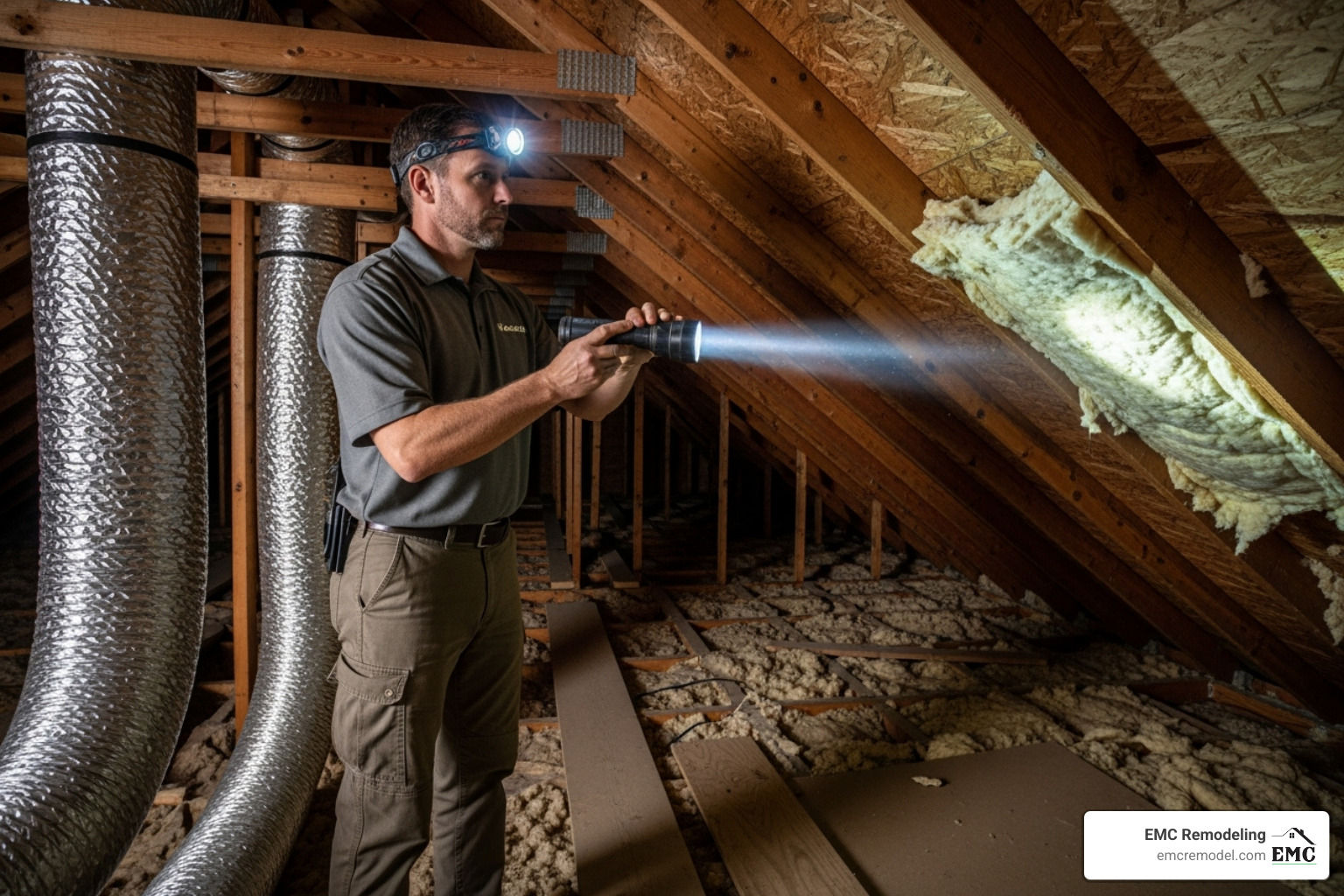Why Your Attic Shouldn’t Be an Out-of-Sight, Out-of-Mind Space
A roof and attic inspection is a comprehensive evaluation of your home’s roofing system from both exterior and interior perspectives, examining everything from shingles and flashing to insulation and ventilation. Here’s what this critical assessment covers:
Key Components of a Roof and Attic Inspection:
- Exterior roof examination – shingles, flashing, gutters, and penetrations
- Attic interior assessment – insulation levels, ventilation, and structural elements
- Leak detection – water stains, mold, and moisture damage
- Pest identification – droppings, nests, and damaged materials
- Structural evaluation – rafters, trusses, and roof decking condition
Your home’s roof and attic work together as a complex system that protects your entire household from the elements, impacts energy bills, and ensures structural integrity. For many homeowners, this vital area remains a mystery – but ignoring it can lead to costly problems.
The stakes are high. Water damage repairs cost $3.75 to $7 per square foot, while average roof repairs run $1,100. Attic insulation replacement averages $1,700 to $2,100. Even small issues can escalate quickly in Central Texas, where intense heat and sudden storms put extra stress on roofing systems.
A proactive approach, including regular inspections, is the best way to maintain your home’s health and value. Understanding what a comprehensive evaluation entails is the first step toward protecting your investment. For homeowners seeking reliable roofing solutions, ensuring your home is prepared for everything from summer heat to sudden storms starts with a thorough look up.
I’m Matthew Runyon, President of EMC Remodeling & Roofing, and I’ve spent over 15 years helping Central Texas homeowners protect their most valuable investment through comprehensive roof and attic inspection services. My experience has shown me that most major roofing problems start small and hidden – which is why understanding your home’s upper levels is so crucial.
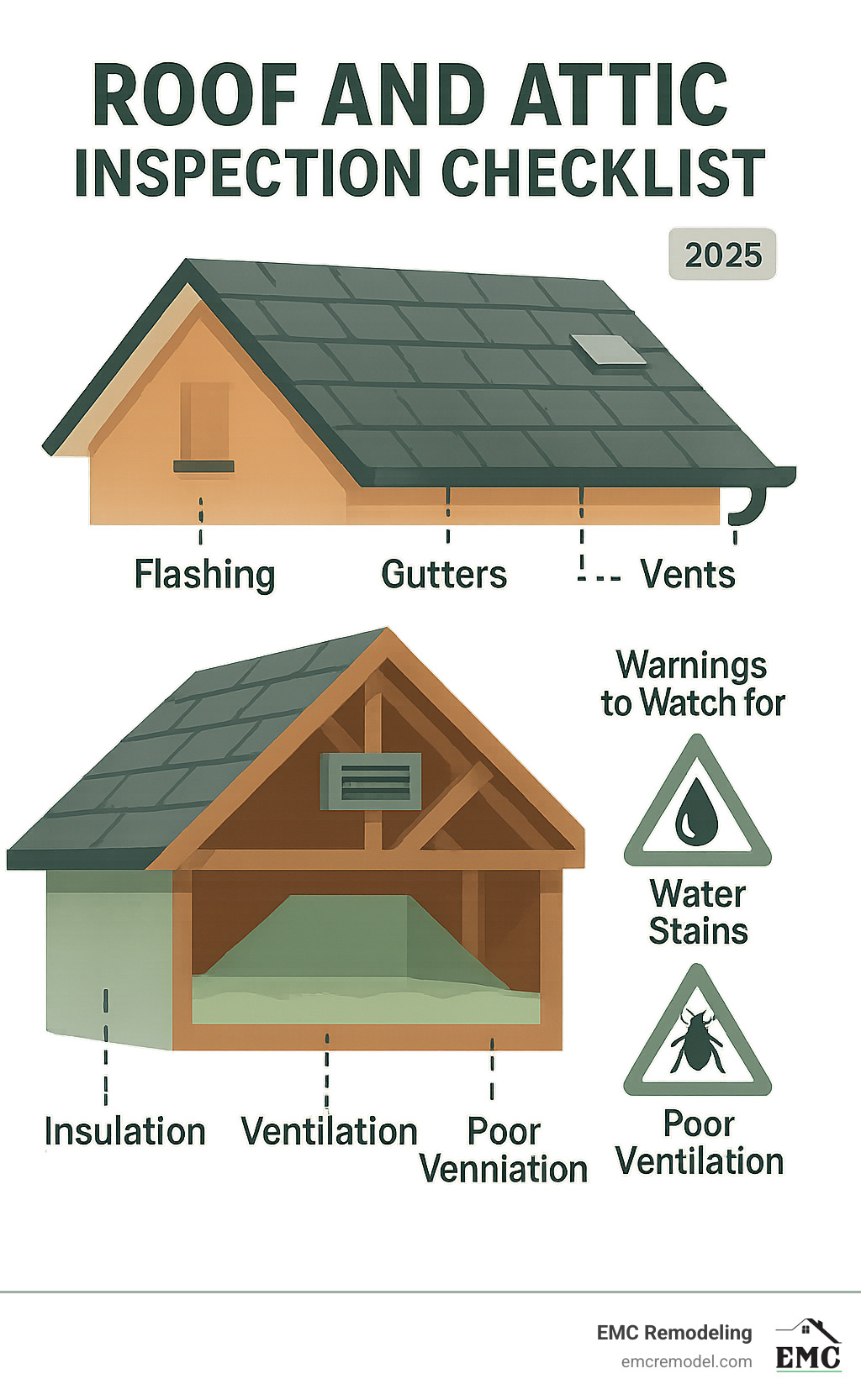
Why a Combined Roof and Attic Inspection is Crucial for Homeowners
Think of your roof and attic as dance partners – they need to work together perfectly, or the whole performance falls apart. When you get a roof and attic inspection, you’re not just checking for obvious problems like missing shingles. You’re getting a complete picture of how these two critical systems support each other to keep your home safe, comfortable, and efficient.
Here’s the thing about roofs and attics: they’re sneaky. Problems often start small and hidden, like a tiny leak that slowly damages insulation or a blocked vent that creates moisture buildup. By the time you notice water stains on your ceiling or feel drafts in your living room, the damage has already been happening for months – maybe even years.
A comprehensive roof and attic inspection serves as your home’s annual physical exam. It catches those small issues before they become big headaches, identifies hidden problems that aren’t visible from the ground, and helps you understand how your home’s systems are really performing. Most importantly, addressing minor repairs now can significantly extend your roof’s lifespan and save you thousands down the road.
For homeowners looking for reliable roofing solutions in Central Texas, this proactive approach is especially important given our extreme weather conditions and intense summer heat.
The Financial Impact of Neglect
Let’s talk numbers – because ignoring your roof and attic hits your wallet hard. I’ve seen too many homeowners find the painful truth that small problems become expensive disasters when left unchecked.
Water damage repair costs between $3.75 and $7 per square foot. That small leak you’ve been meaning to check? It could be quietly saturating your insulation, damaging drywall, and even compromising your home’s structural elements. What starts as a $200 repair can quickly become a $5,000 remediation project.
The average roof repair costs around $1,100. While that might make you wince, it’s nothing compared to a full roof replacement, which can easily run $15,000 to $30,000 or more. Attic insulation replacement averages $1,700 to $2,100 – often necessary when insulation becomes wet, moldy, or compacted due to prolonged moisture issues.
Regular roof and attic inspection services aren’t just an expense – they’re an investment in your home’s future. Early detection and timely repairs lead to substantial long-term savings and protect your property value in Central Texas’s competitive real estate market.
If you’re dealing with storm damage, understanding how to steer insurance roof claims becomes crucial for protecting your financial well-being.
Protecting Your Home’s Health and Structure
Beyond the dollars and cents, your roof and attic directly impact your family’s health and your home’s structural integrity. These aren’t just construction details – they’re the foundation of a safe, comfortable living environment.
Preventing mold growth starts with moisture control. When water gets trapped in your attic through leaks or poor ventilation, it creates the perfect breeding ground for mold. Mold doesn’t just stay put – it spreads rapidly, causing respiratory problems for your family and eating away at your building materials. A professional inspection helps identify and address moisture sources before mold takes hold.
Maintaining good air quality depends on keeping your attic clean and dry. Mold spores, dust, and allergens from pest infestations can circulate throughout your home’s air system, affecting everyone who lives there. Your attic might be out of sight, but its condition directly impacts the air you breathe every day.
Identifying structural damage is where the attic really shows its value as a diagnostic tool. From inside your attic, we can spot a sagging roof deck that indicates water damage or insufficient support. We examine weakened trusses or rafters – the wooden framework that holds up your entire roof. Cracks, rot, or excessive bending in these components can compromise your roof’s stability and, in severe cases, threaten your home’s safety.
Ensuring home safety means addressing multiple risks that often go unnoticed. Structural issues can lead to catastrophic failures. Pest infestations can chew through electrical wires, creating fire hazards. Unaddressed moisture problems can weaken your home’s foundation over time. Regular inspections help you stay ahead of these dangers, keeping your home the safe haven it should be.
The Comprehensive Inspection Checklist: From Shingles to Joists
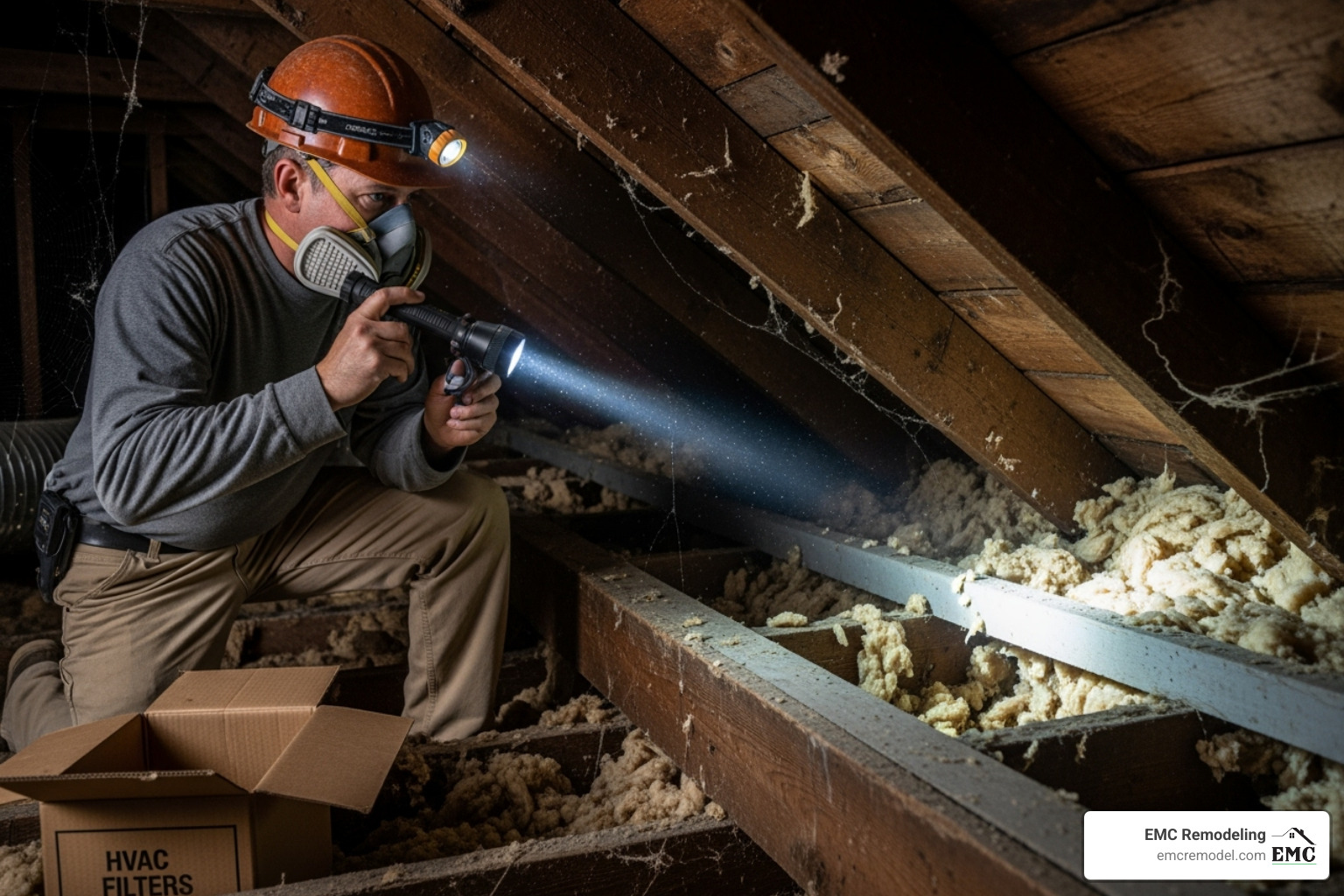
When I conduct a roof and attic inspection, I approach it like a detective solving a mystery. Every component tells a story about your home’s health, and my job is to read those clues before they become expensive problems. This systematic evaluation covers every detail, inside and out, because in roofing, the devil truly is in the details.
Exterior Roof Examination: Your Home’s First Line of Defense
Your roof faces a daily battle against Central Texas weather, from scorching summer heat to sudden hailstorms. During the exterior examination, I’m looking for signs of how well it’s holding up to this constant assault.
Roofing materials each have their own personality and failure patterns. Whether you have asphalt shingles, metal, tile, or another option, I assess how your specific material is performing. Different roofing material options each have unique characteristics that affect their longevity and maintenance needs.
Shingle condition tells me a lot about your roof’s age and health. I look for curling where edges turn upward or downward like potato chips, cracking that creates entry points for water, and granule loss that leaves dark spots on your shingles. Those granules aren’t just decorative – they’re your roof’s sunscreen, protecting the asphalt from UV damage.
Flashing and sealants are the unsung heroes of your roofing system. These components around chimneys, skylights, vents, and wall junctions are where most leaks actually start. I check for rust, bending, lifting, or cracked sealants. It’s amazing how often a $20 tube of sealant could have prevented a $2,000 repair.
Your gutters and downspouts do more than just handle rainwater – they protect your entire home’s foundation. I look for clogs, proper slope, secure attachment, and signs of overflow. Clogged gutters can back water up under your shingles, damaging fascia and soffit, and even threatening your foundation. Downspouts should direct water at least 4-6 feet away from your home, though 10 feet is even better.
Roof penetrations like vents, chimneys, and skylights are necessary but create potential weak points. I examine their seals, caps, and overall condition for any cracks or gaps. These spots need extra attention because they’re where water loves to sneak in.
Signs of algae or moss might look harmless, but they’re actually moisture traps that accelerate material breakdown. Those dark streaks from algae and the green cushions of moss can lift shingles and create entry points for water.
A Deep Dive into Your Attic: What the Pros Look For
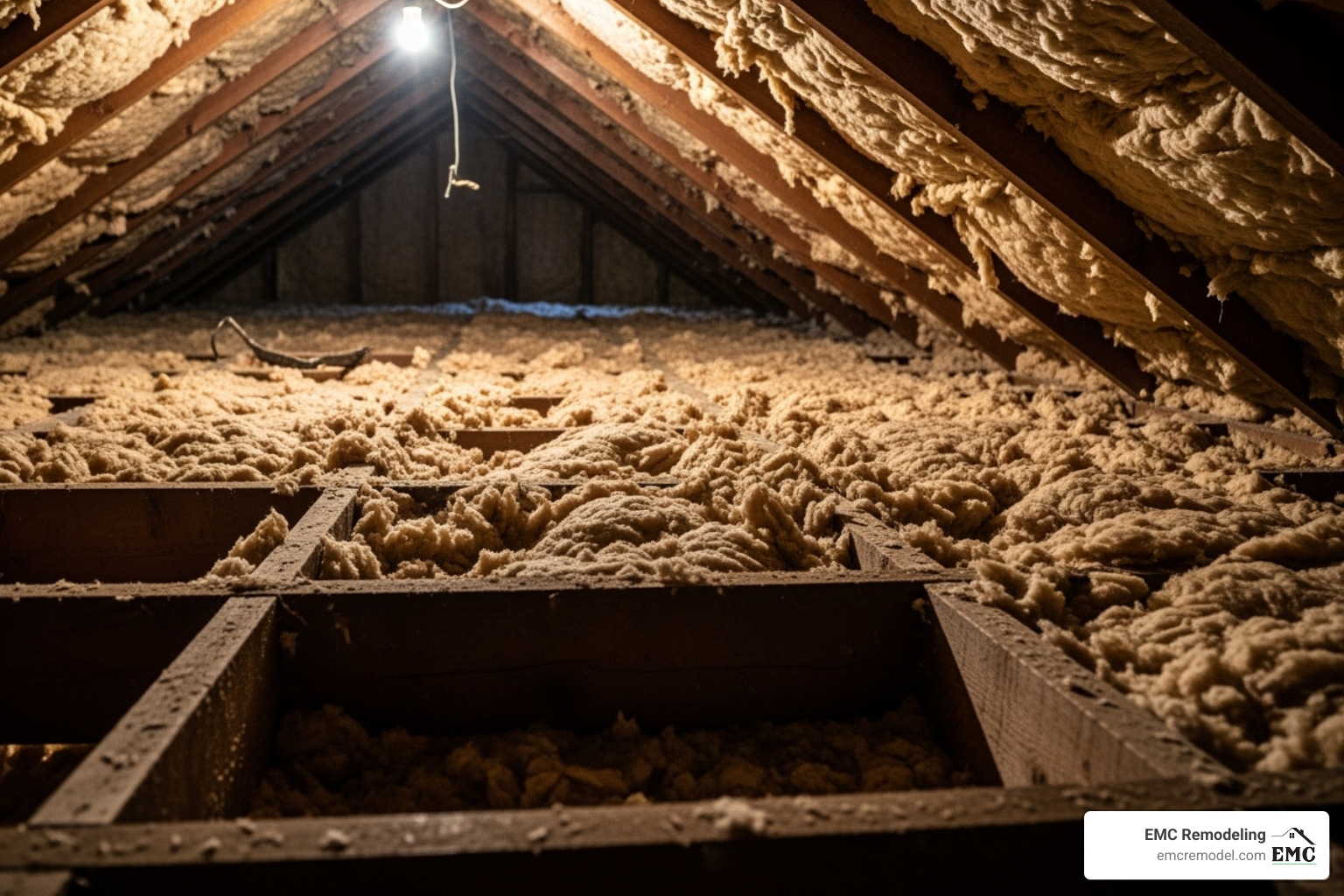
The attic is where the real detective work happens. This space reveals problems that might be completely invisible from the outside, making it one of the most important parts of any roof and attic inspection.
Insulation levels and condition directly impact your comfort and energy bills. I examine the type, depth, and condition of your insulation, checking for consistency, compaction, moisture damage, or areas where it’s settled. A quick rule of thumb: if your insulation is level with or below your floor joists, you probably need more. Proper insulation can save you about 15% on energy costs, making it one of the best investments you can make. Energy Star offers guidance on how to determine if you need more insulation for optimal efficiency.
Ventilation through soffit and ridge vents is crucial for preventing moisture buildup and regulating temperature. I look for signs of poor airflow like condensation on the roof sheathing, rusted nails (a telltale sign of moisture), or an excessively hot, stuffy attic. A well-ventilated attic should stay cooler than 110 degrees even in summer heat. Soffit vents provide intake while ridge vents handle exhaust – they work together like your home’s breathing system.
Structural elements including rafters, trusses, and sheathing are the bones of your roof. I inspect for cracking, rotting, or sagging in the wooden framework. The roof sheathing – that plywood or board deck under your shingles – gets special attention for water damage, delamination, or buckling. These issues can compromise your entire roof’s structural integrity.
Signs of leaks like water stains, dark spots, wood rot, or mold growth often show up in the attic first. Leaks don’t always come from obvious holes – they commonly develop around vents, plumbing stacks, and chimneys. I use moisture meters to tell the difference between old, dried stains and active leaks, because liftd moisture levels suggest a current problem that needs immediate attention.
Pest infestations turn attics into expensive damage zones. I look for droppings, nests, chewed insulation or wood, and damaged wiring. Pests don’t just destroy insulation – they can chew through electrical wires, creating serious fire hazards. I follow the “4 Ds” approach: Droppings, Destruction, Debris, and Dead bugs.
Improperly routed exhaust ducts remain surprisingly common even decades after code changes. Bathroom fans, dryer vents, and kitchen exhausts should never terminate in your attic – they need to vent outside. When warm, moist air gets dumped into your attic, it creates condensation, mold growth, and insulation damage. I ensure all exhaust ducts are properly connected, sealed, and vented to the exterior where they belong.
DIY vs. Professional Roof and Attic Inspection
When it comes to a roof and attic inspection, the question isn’t really whether you can do it yourself – it’s whether you should. I’ve seen plenty of well-intentioned homeowners who climbed into their attic with good intentions, only to miss critical issues or, worse, put themselves in danger.
The truth is, both approaches have their place. A basic DIY check can help you stay connected with your home’s condition and catch obvious problems early. But there are significant differences in safety considerations, the specialized tools available, and the depth of expertise and experience that professionals bring to the table.
Think of it this way: you might change your car’s oil, but you probably wouldn’t attempt to rebuild the engine. The same principle applies here. A DIY inspection offers immediate action and no upfront cost, but it comes with real limitations. A professional inspection provides the comprehensive reports and thorough assessment that can save you thousands down the road.
Performing a Safe DIY Attic Inspection
If you decide to take a peek into your attic yourself, safety absolutely must be your top priority. Attics can be surprisingly dangerous spaces – between unstable footing, protruding nails, and potential electrical hazards, one wrong step can turn a simple inspection into a trip to the emergency room.
Here are the essential safety precautions that I always recommend:
- Stable Access: Use a sturdy, properly placed ladder to access your attic. Make sure it’s secure and have someone spot you if possible.
- Protective Gear: Wear a dust mask or respirator to protect against insulation fibers, dust, and mold spores. Safety glasses will shield your eyes from debris, while gloves and a long-sleeved shirt protect your skin from irritants and sharp objects. A hard hat or cap is also smart protection against those roofing nails that love to poke through the sheathing.
- Secure Footing: This is the most critical rule. Only walk or place weight on the attic joists or trusses – never on the drywall ceiling below or the insulation. If insulation covers the joists, carefully dig around to locate them. Lay down a piece of plywood across several joists to create a stable platform.
- Proper Lighting: A bright flashlight or headlamp keeps your hands free for stability and inspection.
- Awareness: Before you fully enter, scan the area for sharp, protruding roofing nails, exposed electrical wiring, and signs of pests. Move slowly and deliberately.
Timing matters too. Inspecting your attic on a cooler day or during spring and fall makes the experience more comfortable and safer. Central Texas summers can turn attics into ovens, making inspection both uncomfortable and potentially dangerous.
If you feel fatigued or uneasy at any point, exit the attic and consider calling a professional. No inspection is worth risking your safety.
When to Hire a Professional for Your Roof and Attic Inspection
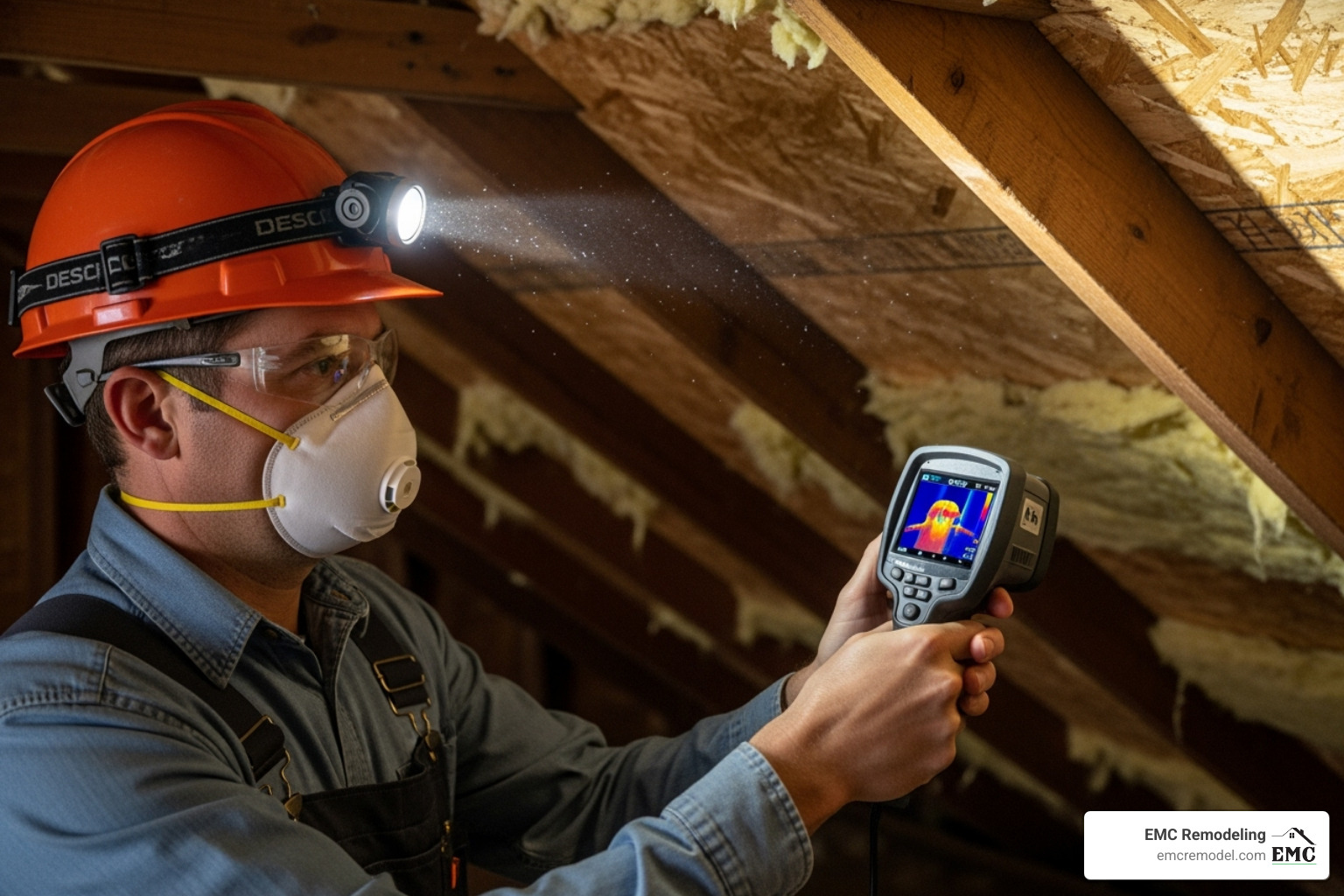
While a DIY check can provide a preliminary overview, there are many situations where hiring a professional for your roof and attic inspection isn’t just recommended – it’s essential.
Identifying hidden issues is where professionals really shine. We have the trained eye and experience to spot subtle signs of damage that might be invisible to an untrained homeowner. We understand the nuances of structural integrity, ventilation dynamics, and how material degradation progresses over time.
Using specialized equipment takes the inspection to another level entirely. We use moisture meters to detect hidden water intrusion within building materials, and infrared cameras (thermal imaging) to identify temperature differences that reveal insulation gaps, air leaks, or hidden moisture behind walls and ceilings. These tools provide insights far beyond what’s visible to the naked eye.
Providing detailed reports becomes crucial for real estate transactions or insurance claims. When buying or selling a home, or filing an insurance claim after storm damage, a comprehensive, unbiased report from a certified professional is invaluable documentation of your roof and attic’s condition.
Ensuring safety on steep or complex roofs is another area where professionals excel. Attempting to inspect a steep, multi-level, or complex roof can be extremely dangerous. We have the necessary safety equipment and training to access and thoroughly inspect these areas without risking injury.
The cost-benefit analysis usually favors professional inspection. Typical inspection costs range between $200 and $500 – a small investment compared to the potential cost of undetected problems. While attic inspections might cost $200-$500, addressing issues like extensive water damage or roof repairs can quickly amount to thousands.
Finding a reputable inspector requires some homework. Look for recommendations, check online reviews, and verify licenses and insurance. Check for certifications from organizations like the American Society of Home Inspectors (ASHI) or the National Roof Certification & Inspection Association (NRCIA). Their expertise ensures a thorough and reliable assessment.
The benefits of professional roof inspection services extend far beyond just finding problems – they provide peace of mind, accurate diagnosis, and expert recommendations for any necessary repairs or maintenance.
Frequently Asked Questions
Homeowners often have specific concerns about roof and attic inspection services. After years of helping Central Texas families protect their homes, I’ve noticed certain questions come up time and again. Let me address the most common ones we encounter at EMC Remodeling.
How often should I have a roof and attic inspection?
Here’s the straightforward answer: every 1-2 years for routine maintenance. Think of it like getting your car serviced – regular check-ups prevent bigger problems down the road.
But life doesn’t always follow a neat schedule. You’ll want to schedule an inspection sooner if you notice warning signs like water stains creeping across your ceiling, your energy bills suddenly spiking, or that musty smell that seems to appear out of nowhere. These are your home’s way of asking for help.
Severe weather events are another trigger for immediate inspection. In Central Texas, we’re no strangers to sudden hailstorms, powerful winds, and the occasional tornado. Even if everything looks fine from the ground, hidden damage can lurk beneath the surface. I’ve seen too many homeowners find expensive problems months later because they assumed their roof was fine after a storm.
Real estate transactions also call for professional inspection. Whether you’re buying or selling, knowing exactly what you’re dealing with prevents unpleasant surprises. For homeowners in areas like Belton, TX, staying ahead of weather-related damage is key to maintaining your home’s value and your family’s safety.
How do conditions like snow cover impact an appraisal inspection?
While we don’t see much snow here in Central Texas, this question matters for anyone dealing with FHA appraisals or relocating from colder climates.
HUD/FHA guidelines are clear: appraisers must still make every effort to examine the roof and inspect the attic for problems, even when snow covers the exterior. This means they’ll look for water stains, moisture damage, and structural issues from inside your attic, using the interior as a window into your roof’s health.
When the roof remains hidden under snow, the appraiser will document this limitation in their report. The lender might then require additional certification from a qualified roofing professional or establish an escrow account to cover potential repairs once conditions improve. It’s their way of ensuring the property meets safety and soundness standards, even when Mother Nature doesn’t cooperate.
What is the difference between a general home inspection and a dedicated roof inspection?
This distinction is crucial, and many homeowners don’t realize there’s a significant difference until it’s too late.
A general home inspector is like a family doctor – they know a little about everything. They’ll check your plumbing, electrical systems, HVAC, and yes, your roof. But their roof assessment is often limited to what they can see from the ground or a ladder. They’re trained to spot obvious problems but might miss the subtle signs that spell trouble.
A dedicated roof inspection from a qualified roofing contractor is more like seeing a specialist. We bring specialized knowledge about roofing materials, their expected lifespans, and their unique failure patterns. We use professional-grade tools like moisture meters and thermal cameras to detect hidden problems that aren’t visible to the naked eye.
The depth of analysis is dramatically different. While a general inspector might note “shingles appear worn,” a roofing specialist will assess the specific type of granule loss, evaluate the remaining lifespan, identify the likely causes, and recommend precise solutions. We examine your attic’s insulation levels, ventilation effectiveness, and proper exhaust routing – all critical factors that affect your roof’s health but often overlooked in general inspections.
For true peace of mind about your home’s most important protective barrier, especially after severe weather or before making a major investment, a specialized roof and attic inspection is always the superior choice. The comprehensive analysis and expert recommendations you receive make it worth the focused attention your roof deserves.
Conclusion: Protecting Your Investment from the Top Down
A thorough roof and attic inspection is one of the most important preventative maintenance tasks a homeowner can undertake. It safeguards your home’s structural integrity, improves energy efficiency, and prevents minor issues from escalating into major financial burdens.
Think of it this way: your roof and attic work as a team to protect everything you hold dear. When this team is functioning well, you stay comfortable, your energy bills stay reasonable, and your home maintains its value. When something goes wrong up there, the effects ripple through your entire house.
The investment in regular inspections pays for itself. Remember those sobering numbers we discussed earlier? Water damage repairs averaging $3.75 to $7 per square foot, roof repairs around $1,100, and attic insulation replacement costing $1,700 to $2,100. A $200 to $500 professional inspection can help you avoid these much larger expenses.
By understanding what to look for and when to call a professional, you can ensure your home remains safe, comfortable, and secure for years to come. Whether you choose to do a basic DIY safety check or invest in a comprehensive professional evaluation, the key is staying proactive rather than reactive.
For homeowners in Central Texas, the stakes are even higher. Our unique climate – from scorching summers that can make attics reach 150°F to sudden hailstorms that can damage shingles in minutes – puts extra stress on roofing systems. At EMC Remodeling, we understand these challenges intimately. Our owner-led, transparent service ensures you receive top-rated craftsmanship and a clear understanding of your roof and attic’s condition.
Don’t wait until you see water stains on your ceiling or feel a draft in your living room. Your home’s most critical shield deserves regular attention. For a complete and professional evaluation that’s custom to Central Texas conditions, schedule your roof and attic inspection today.
